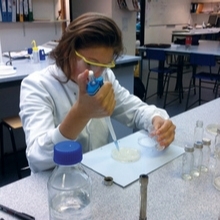Schoolzone: A taste of honey
Issue: Antimicrobials
01 November 2012 article

IAN RICHARDSON & ANNABEL LARGE
THE EXTENDED ESSAY is an essential component of the International Baccalaureate diploma course for students studying at Rydal-Penrhos School in North Wales. Students have to decide on a subject and a specific area of interest early in the lower sixth. In biology, they are encouraged to research their chosen area and develop research and practical skills. Both organisation and planning are crucial, especially in a practical-based subject. They must learn to work within a department and plan the use of resources and lab time. This is done under the watchful eye of a supervisor, who guides and provides a framework in the form of checkpoints over the year to monitor progress.
This year we were fortunate for one student to establish a link with the SGM that enabled us to utilise their knowledge and resources – the link was established after a speculative phone call. The antimicrobial properties of honey was at the heart of the discussion after the student, Annabel Large, had read various articles about manuka honey and its historical use as a treatment against bacterial infection. It was not long after this initial contact that Annabel was advised to contact various University lecturers and the whole project suddenly burst into life. The whole experience has been very positive from a supervisor’s point of view and I am very grateful for the time and effort the scientists have invested in Annabel’s project.
IAN RICHARDSON
Email [email protected]
INITIALLY, I WAS QUITE DAUNTED by the ‘extended essay’; I had no idea what topic to pursue, what was accessible or most appropriate. However, I was clear that it was going to be a science-based project. A BBC news article discussing honey also inspired me with its potential to act as an antimicrobial agent to counter hospital-acquired infections like MRSA. This had me captivated to think that a substance like honey could be used to breakdown and weaken a complex resistant strain of bacteria that has been troubling the medical profession for years. At this point I was advised to contact the SGM, I wasn’t expecting much feedback as a sixth form student and did not think anyone would be that interested. But, I was absolutely taken aback by the response I received. The SGM team put me in contact with Jenny Hawkins at Cardiff University and Dr Sarah Maddocks, an associate lecturer at Cardiff School of Health Sciences. Both replied in great detail and right from the start they reassured me that it would be possible to conduct an experiment to replicate some of their findings. They sent further articles, research papers and even discussed general methodology and appropriate microbes to use. They introduced me to the ‘Microbiology Twitter Journal Club’, which I logged onto and received insightful findings from other researchers.
As a result of this input my research question was conceived, ‘Do the antimicrobial properties of regional honey differ to manuka honey and how could these unique antimicrobial properties be incorporated in modern medicine in the fight against resistant strains of bacteria?’ The use of local honey was unique in my project because both centres had never tested honey from North Wales. As a result of the collaboration I agreed to supply the honey I tested to both research establishments.
Throughout my investigation, I had continued support from these leading researchers and I would strongly advise anyone to do the same. Although challenging at times, it has been an extremely worthwhile and exciting experience. I owe a great debt of thanks to the SGM staff and Dr Maddocks and Jenny Hawkins in Cardiff. I am happy to report the first draft is now written and I am well on the way to completing the task!
ANNABEL LARGE
Image: Annabel in the lab. I. Richardson.
